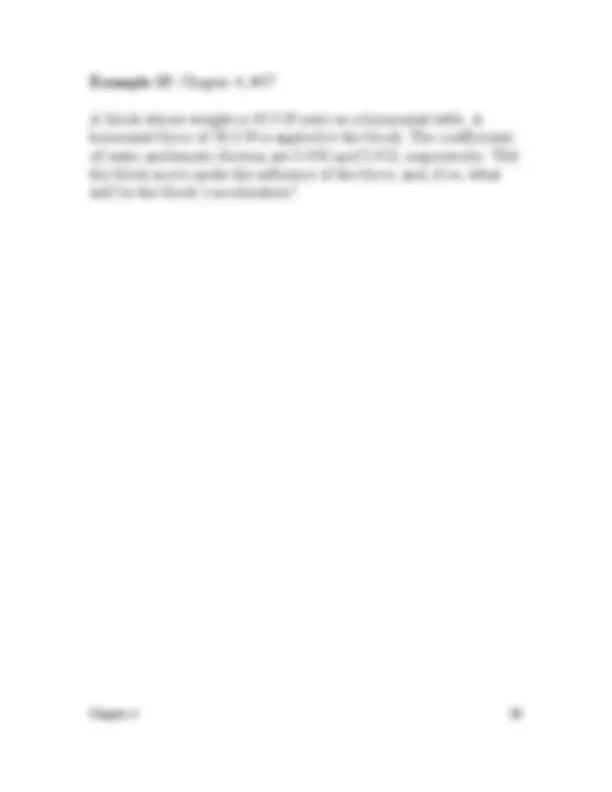





Study with the several resources on Docsity

Earn points by helping other students or get them with a premium plan


Prepare for your exams
Study with the several resources on Docsity

Earn points to download
Earn points by helping other students or get them with a premium plan
Community
Ask the community for help and clear up your study doubts
Discover the best universities in your country according to Docsity users
Free resources
Download our free guides on studying techniques, anxiety management strategies, and thesis advice from Docsity tutors
Material Type: Notes; Class: Essential Physics; Subject: Physics; University: Duquesne University; Term: Unknown 1989;
Typology: Study notes
1 / 6

This page cannot be seen from the preview
Don't miss anything!




Chapter 4 28 4.9 Static and Kinetic Frictional Forces Static Friction – “static” means no movement. Static Friction has two main characteristics restriction / assumption: macroscopic (can see) objects Characteristic 1 – Static friction is independent of the area of contact between the surface and object restriction / assumption: hard and nondeformable surfaces Characteristic 2 – The magnitude of the static frictional force is proportional to the normal force. The constant of proportionality is called the coefficient of static friction, denoted by € μ s and is a unitless quantity. The coefficient of static friction is, not surprisingly, material dependent among other things (temperature, material’s condition (rough, polished))… The magnitude of the static frictional force can be zero to a maximum amount of € fs max^ , depending on the applied force. The maximum value of this force is just before the object starts to move. This is stated mathematically by the (very important and often used) condition € fs max^ = μ sFN As the book mentions, this only relates the magnitudes of the normal and static forces (and in this case the lack of arrows indicates magnitude). Forces are vectors and these vectors do not act in the same direction! However, this relationship ties components together and goes back to the vector nature of €
F = m
Kinetic Friction – “kinetic” means motion is present Kinetic Friction has three main characteristics restriction / assumption: macroscopic objects Characteristic 1 – Kinetic friction is independent of the area of contact between the surface and object restriction / assumption: hard and nondeformable surfaces Characteristic 2 – Kinetic friction is independent of the speed of sliding motion restriction / assumption: the speed is small Characteristic 3 – The magnitude of the kinetic frictional force is proportional to the normal force. The constant of proportionality is called the coefficient of kinetic friction, denoted by € μ k , and is a unitless quantity. The magnitude of the kinetic frictional force is given by € fk = μ k FN The same warning applies, this relates the magnitudes of the two forces. Both static and kinetic friction act in a direction to oppose motion whether that motion is occurring or could potentially occur.
A 81-kg baseball player slides into second base. The coefficient of kinetic friction between the player and the ground is μk = 0.49. (a) What is the magnitude of the frictional force? (b) If the player comes to rest after 1.6 s, what is his initial speed?
An ice skater is gliding horizontally across the ice with an initial velocity of +6.3 m/s. The coefficient of kinetic friction between the ice and the skate blades is 0.081, and air resistance is negligible. How much time elapses before her velocity is reduced to +2.8 m/s?